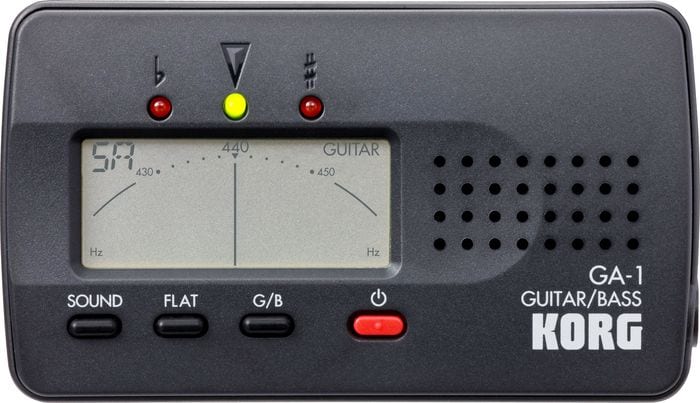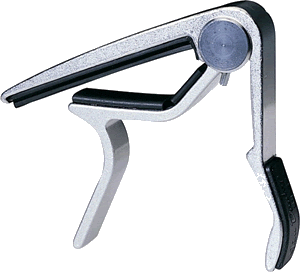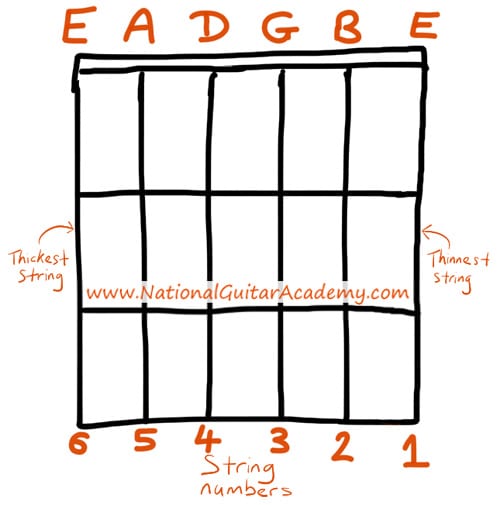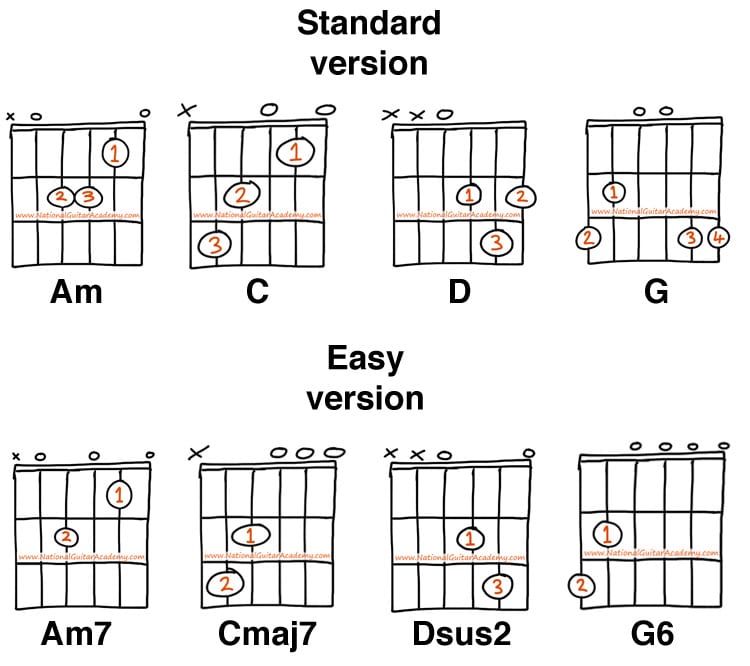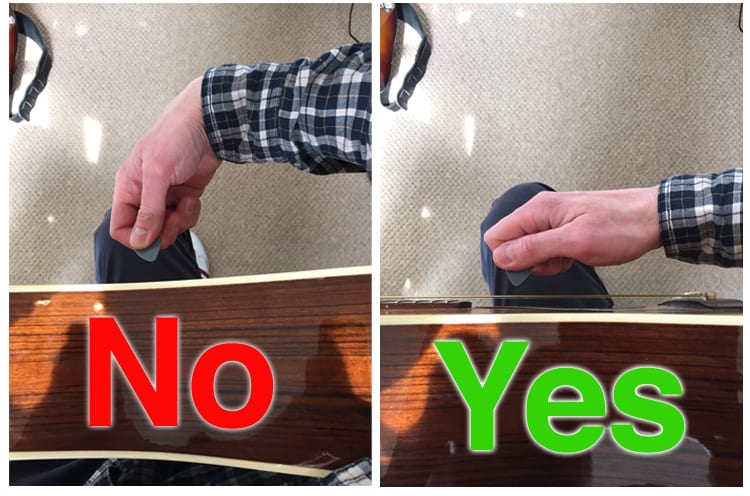Learn classical guitar the easy way with our 7-step program. Ready to get started? Let’s do it.
In this free guide you’ll learn everything you need for a perfect start.
- Quick-start gear guide: Guitars, tuners, picks, capos
- The secret way to learn chords at lightning speed
- 10 easy songs for guitar beginners
- How to strum with rhythm and musicality
- How to hold a pick correctly
- The most effective way for beginners to practice
Over 100,000 guitar-learners get our world-class guitar tips & tutorials sent straight to their inbox:
Click here to join them
Get our best guitar tips & videos
Ok, let’s dive in and look at the first step in your quest to learn classical guitar..
Classical guitars (AKA ‘Spanish guitars’) are beautiful instruments with an articulate and warm tone.
We put this free guide together for you to help you get the best possible start in your classical guitar journey. We hope you enjoy it. 🙂
Learn classical guitar step 1: Buy the essentials
Ok, let’s quickly run through the essential bits and pieces you need.
Obviously, you’ll need a classical guitar (the Yamaha C40 is our recommended ‘best buy’) and you’ll also need a bag or case to keep it safe from harm.
You’ll also need a guitar tuner. (There’s tons of decent tuners out there. The Korg GA-1 is one of our favourites.)
You’ll also need a capo. The capos from Jim Dunlop are superb:
If you intend to play the guitar standing up, then buy a strap. If not, don’t. (Straps get in the way and are a barrier between you and your guitar. Don’t buy one unless you genuinely need it.)
Lastly, you’ll need to buy 5-10 guitar picks (a pick thickness of 0.65-0.73 is best for classical guitar beginners).
.
How to tell a classical guitar from a standard acoustic guitar
The easiest way to spot a classical guitar (vs a standard acoustic) is to look at how the strings are attached to the bridge.
On a classical guitar the strings are made of nylon and are wound in a loop around the bridge, like this:
On a standard acoustic the strings are made of metal and are threaded through the bridge and secured with pegs.
Ok, let’s move on and look at the strings and tuning of your classical guitar.
.
Learn classical guitar step 2: Learn the notes (and numbers) of your guitar strings
This is essential of course. If you want to learn classical guitar you must be able to read chordboxes and tabs (and you need to know the notes and strings to be able to communicate with other guitarists).
The guitar strings from thickest to thinnest are: E A D G B E.
Here’s a couple of fun ways to remember this:
Eddie Ate Dynamite, Good Bye Eddie.
Or you could use…
Elephants And Donkeys Grow Big Ears.
You choose!
To learn more about guitar notes and the musical alphabet (including ‘sharps’ and ‘flats’) check out our guide: Guitar Notes Explained: A Guide For Beginners
Learn 12 EASY beginner chords with our popular guide


Where should we send it?
✅ Stop struggling. Start making music.
✅ Learn beginner-friendly versions of every chord.
This is our most popular guide and it will improve your chord ability quickly! 😎
Get your own personalised guitar-learning plan 🎸
Get a custom guitar-learning plan here: Click here for GuitarMetrics™
World-Class Guitar Courses 🌎
Learn from the world's best guitar educators: Click here for our guitar courses
This is vital! Can you tune your guitar correctly?
Read Rob’s article to learn more about tuners and how to tune your classical guitar: How To Tune A Guitar: A Beginner’s Guide
.
Want free guitar tips and video lessons delivered to your inbox?
Join over 100,000 guitar learners and subscribe to our guitar-tips-by-email service. (It's free.)
We'll send you a series of lessons that will move you to the next level of your guitar journey.
Learn how everything fits together quickly, easily and effectively. We share ninja tips (for instant fun!) but also timeless fundamentals that will deepen your understanding.


Get our best guitar tips & videos
Our Guitar Courses
To become a better guitarist click here to see our guitar courses
Get your personalised guitar-learning plan 🎸
Want us to make a guitar-learning plan that is customised to you? Click here for GuitarMetrics™
Learn classical guitar step 3: Learn basic guitar chords
If you want to learn classical guitar, it’s vital that you learn basic chords.
We have a whole area of the site dedicated to beginner chords that are easy to play so check it out. It will make life easier for you. Chords are a vital part of your journey to learn classical guitar.
The secret to learning chords quickly…
The easiest and fastest path to learn chords is Mike’s ‘stepping-stone’ method.
There is an easy version of every chord. Start off with the easy version!
As a new guitarists, you won’t be able play chords like B or F.
So you have 2 options:
- Chew off your own fingers in frustration…
- Learn an easier version of the chord!
Please pick option 2! This allows you to enjoy creating music and make progress. The whole time you will be improving your control, accuracy and finger dexterity. You will be then be able to ‘graduate’ to the standard and difficult versions of the chord.
Learning guitar is all about momentum and reducing barriers to progress.
Using easy stepping-stone chords is a cornerstone of our teaching philosophy which is proven to work. Ignore this point at your peril! 🙂
.
Example stepping-stone chords
Let’s look at some real examples:
If you don’t understand these diagrams read this: How To Read Chordboxes In 60 Seconds.
(Figuring out how to learn classical guitar will be impossible if you can’t read chordboxes!)
How to learn classical guitar step 4: Learn how to strum
If you want to learn classical guitar, you MUST be able to strum chords rhythmically. This is how we create music.
From the guitar player’s perspective, this is what good strumming looks like:
- Notice that the wrist is (mostly) locked and the big strumming motion is coming from the elbow.
- Check out the way the pick is being held too. (Pause the video to get a good look.)
- The whole arm is a pivot. Think of it as a single ‘piece of wood’.
- The pick is like a nail through the piece of wood, at the end. Pointing in, at the strings.
Overcoming engrained bad habits
If your current strumming technique is very different to this, you will initially feel like you’re ‘dragging’ the pick over the strings when you try the strumming style shown in the video. (And you are, that’s the pick’s job! That’s what it’s meant to do.) This feeling can cause a bit of discomfort, but it will pass quickly.
This is probably the most influential pillar in all guitar playing. In many ways it is guitar playing because all all rhythm is here.
To learn how to strum with rhythm and musicality read this: How To Strum A Guitar: The Ultimate Guide
How to hold a pick correctly
Most beginners see this as a small detail, but it’s huge! How you make contact with the guitar is very important.
In this image, the pick is being held too far back:
This is a lot better.
Many beginners find picks hard to use so they start strumming with their fingers or (heaven forbid) their thumb.
(Playing with your thumb is a terrible and limiting habit. Please don’t do it! Playing with your fingers is fine, of course.)
If you want to know how to learn classical guitar, you need to be able to play with a pick AND your fingers. Practice with both, but do not abandon the pick.
Avoid the ‘swan-neck’ wrist
Your right arm should run parallel to the body of the guitar and the pick should point inwards.
The swan-neck shape makes almost all right hand techniques impossible to perform and rules out awesome and fundamental percussive styles like deadening and syncopation.
This isn’t an issue for a beginner, but it will stop your growth as an intermediate guitarist. For this reason, the swan-neck wrist must be avoided.
Download our lead guitar cheat-sheet to make things easier
It's hard to understand which scales work with which keys.
So we created a cheat-sheet! A key and scale-finder that you can use again and again.
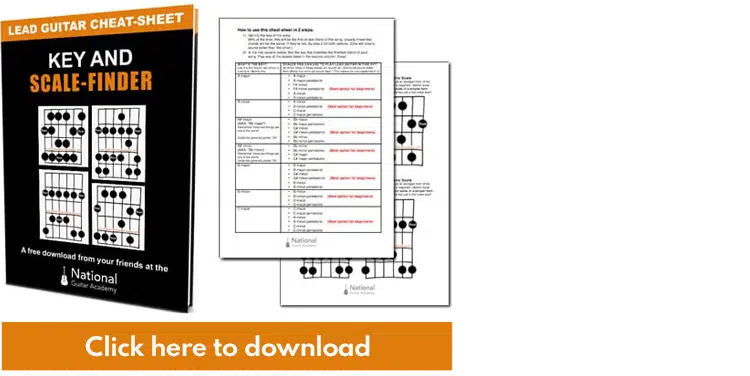
Get your personalised guitar-learning plan 🎸
Get a custom guitar-learning plan here: Click here for GuitarMetrics™
World-Class Guitar Courses 🌎
Learn from the world's best guitar educators: Click here for our guitar courses
Learn classical guitar step 5: Play songs you love
Here’s three facts that should be on your radar as a guitar-learner:
- You will boost your chances of successfully learning the guitar if you practice lots.
- You will practice more if you enjoy practicing.
- You are a lot more likely to enjoy practicing if you LOVE the songs you practice!
Playing music you adore isn’t a ‘bonus’ for guitar learners. It’s required. So abandon songs like ‘twinkle twinkle little star’ & ‘happy birthday’.
Boost your chances of guitar success by learning music you adore. This article will help you and give you some good ideas: 10 Easy Songs For Beginners
Learn classical guitar step 6: Get a good teacher
Forget YouTube! There are many good guitarists on YouTube, but not many good guitar teachers. And there’s a huge difference between those two things. Trust me, I own two guitar schools! 🙂
It often takes 4-5 attempts to find a guitar teacher who is a good fit for you. That’s normal, so expect it.
A good guitar teacher will transform your chances of successfully learning the instrument, so keep looking and don’t get discouraged if after 3 or 4 teachers you still haven’t found one that ‘clicks’ with you.
Important: Learn some scales
As a classical guitarist it will be very useful to know some scales. (At least the major and minor scales.)
Check out this article to get up to speed: Learn Guitar Scales In 8 Easy Steps
Learn classical guitar step 7: Be smart about your practice
Let’s address one of the most frequent questions I get asked…
‘How much should I practice?’
As much as possible, of course, but ideally you should aim to practice for 15 minutes per day. But here’s the thing, just 5 minutes daily will result in you making clear & satisfying progress.
Sometimes my students say things like, “I’m so sorry, I couldn’t practice in this week. I put aside a few hours on Sunday, but then something came up so I couldn’t do it.”
Don’t cram all your guitar practice into one day.
Life means that things often WILL come up. That’s life! 🙂
And even if you’re certain you have a whole day free, you are setting yourself up for a HUGE workload.
Keeping things bitesize just works better on every level. 15 minutes per day is manageable, it won’t raise your stress levels too much (quite the opposite in fact) and if something comes up, well that’s alright.
(If you lose 15 minutes of practice time that’s not something to lose sleep about.)
.
What Type of Guitarist Are You?
Take our 60-second quiz & get your results: Take The Quiz
Join the world's best online guitar school 🌎
- Get your own personalised guitar learning plan (customised just for YOU).
- World-class online guitar courses. Learn at your own pace.
- Community Campus & Learning Forum - A friendly community! Connect with our team & students. 😊
- Beginner Song library with chordsheets, tabs and tips. (Songs suitable for all levels!)
- Regular live streams, seminars and Q&A sessions - Learn from world-class guitar educators. Get all your questions answered!
Click here to learn more about National Guitar Academy membership 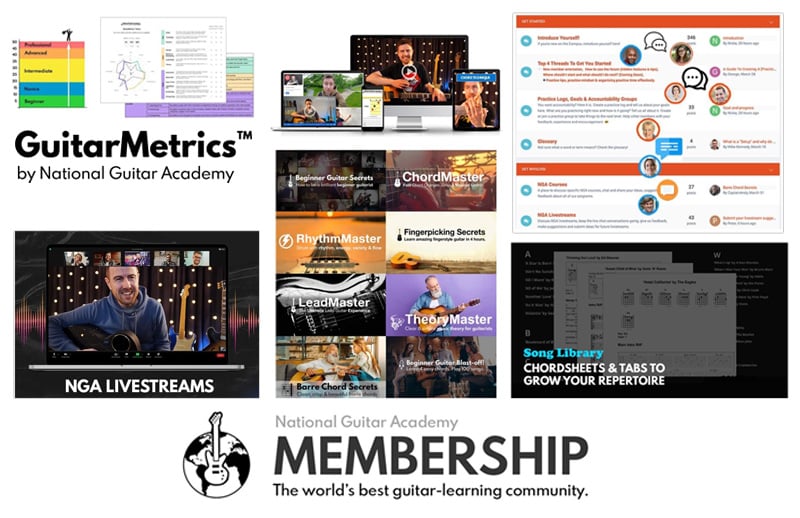
Cool Guitar T-shirts 😎
Look cooler! Check out our merch: Click here to see our merch store
Want free guitar tips and video lessons delivered to your inbox?
Join over 100,000 guitar-learners and subscribe to our guitar-tips-by-email service. (It's free.)
We'll send you a series of lessons that will move you to the next level of your guitar journey.
Learn how everything fits together quickly, easily and effectively. We share ninja tips (for instant fun!) but also timeless fundamentals that will deepen your understanding.


Get our best guitar tips & videos
Popular Lessons
How To Learn Guitar: An 11-Step Programme For Beginners
How To Choose The Perfect Beginner Guitar
More Cool Guitar Stuff
Learn about National Guitar Academy: About Us
Join us on Facebook for daily guitar tips.
Listen to our Learn Guitar Podcast for rapid guitar progress.
Check out our free chord lessons.



